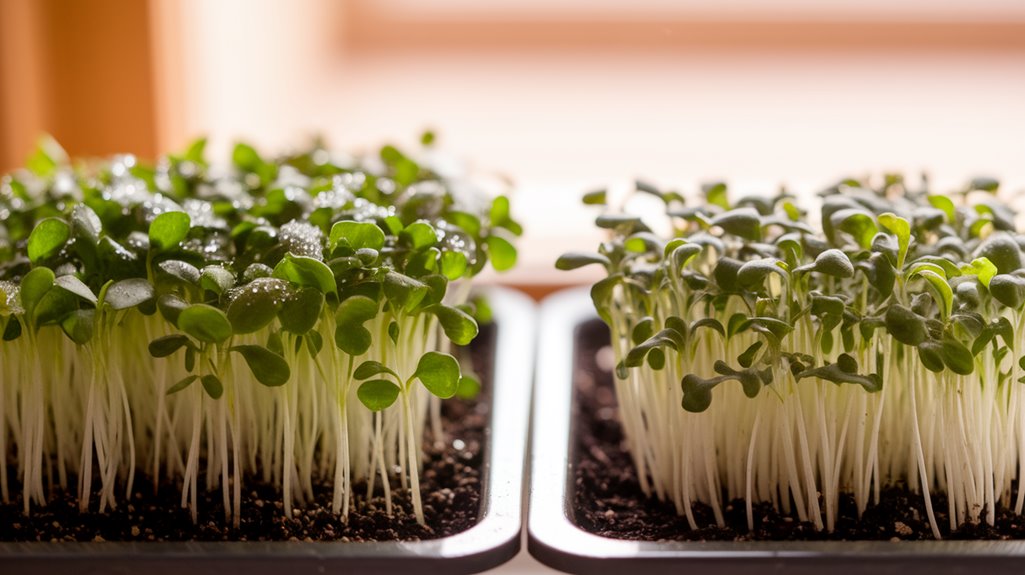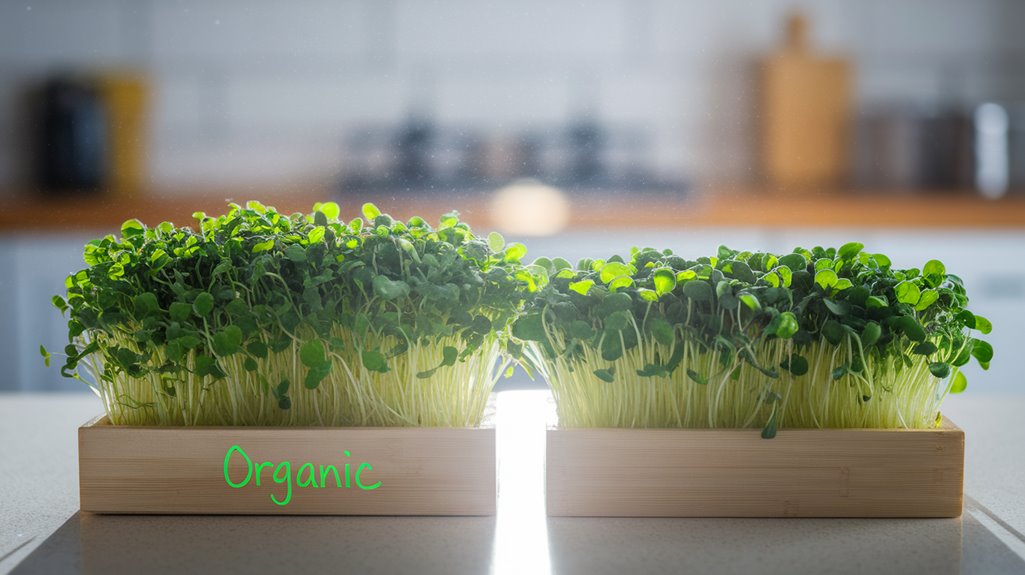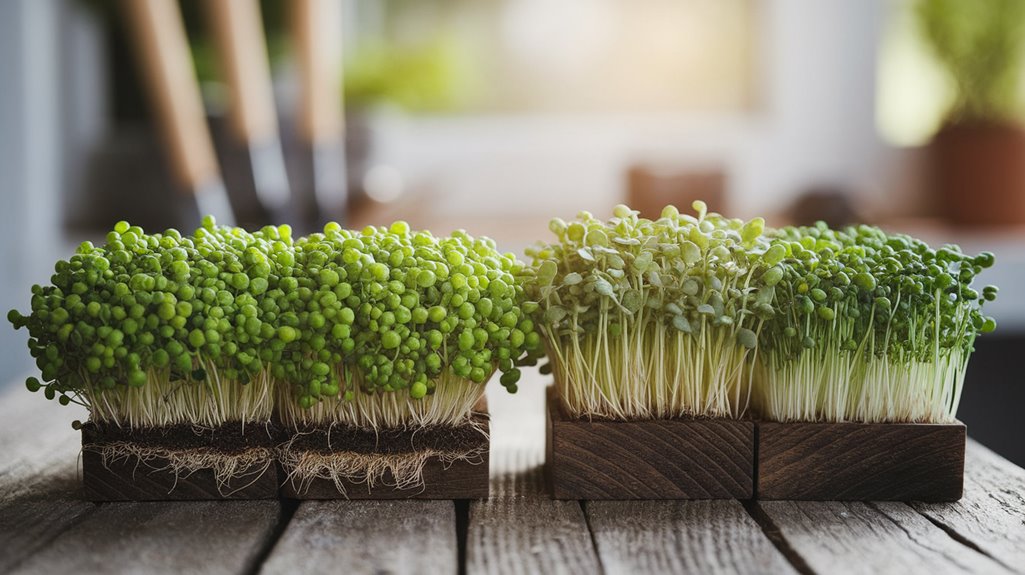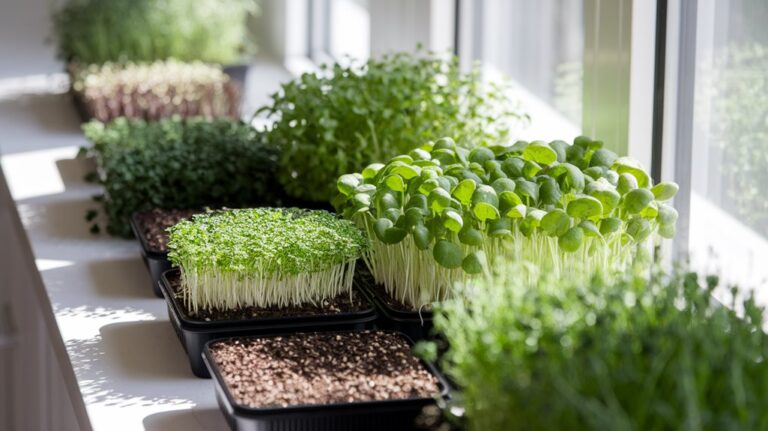Organic vs. Non-Organic Microgreens: What You Need to Know
When choosing between organic and non-organic microgreens, I’ve found that organic options are grown without synthetic pesticides or fertilizers, offering richer nutrients and promoting soil health. While they may cost 20-50% more, their higher nutrient density can lead to long-term health benefits. Non-organic microgreens, on the other hand, are generally more affordable and grow faster due to conventional farming methods. The environmental impacts also differ significantly. There’s much more to explore in terms of growth and health benefits.
Key Takeaways
- Organic microgreens are cultivated without synthetic pesticides or fertilizers, enhancing nutrient density and flavor compared to non-organic varieties.
- Non-organic microgreens are often more budget-friendly due to higher yields and faster growth rates achieved through conventional farming methods.
- Both types are rich in vitamins and antioxidants, but organic varieties may offer up to 40 times more nutrients than their mature counterparts.
- Environmental impacts differ significantly, with organic practices promoting soil health and biodiversity, while non-organic methods can lead to degradation.
- While organic microgreens typically cost 20-50% more, their long-term health benefits and local sourcing may offset higher upfront costs.
Understanding Organic Microgreens

When I think about organic microgreens, I’m often struck by how they represent not just a farming method but a holistic approach to sustainability and health.
These tiny greens are cultivated without synthetic pesticides or fertilizers, promoting a healthier ecosystem. I find it fascinating that organic microgreens are often richer in nutrients compared to their conventionally grown counterparts, thanks to the natural growing conditions.
The soil quality, biodiversity, and absence of chemicals all contribute to their robust flavors and nutritional profiles. Moreover, supporting organic farming practices encourages local economies and reduces carbon footprints.
In my experience, choosing organic microgreens isn’t just about taste; it’s a commitment to a sustainable lifestyle that benefits both our health and the environment.
Exploring Non-Organic Microgreens
While many tout the benefits of organic microgreens, non-organic varieties also play a significant role in the market and offer their own advantages.
Non-organic microgreens are typically grown using conventional farming methods, which can lead to higher yields and lower prices. This makes them more accessible for consumers on a budget.
Additionally, non-organic growers often utilize advanced agricultural technologies, ensuring consistent quality and availability year-round. Furthermore, the use of synthetic fertilizers and pesticides can result in faster growth rates.
However, it’s crucial to consider your sourcing; choosing reputable suppliers can help ensure safety and quality.
Ultimately, non-organic microgreens can still provide a delicious and nutritious option for those looking to diversify their diet without breaking the bank.
Nutritional Benefits of Microgreens

Microgreens, whether organic or non-organic, offer impressive nutritional benefits that make them a valuable addition to any diet. Packed with vitamins, minerals, and antioxidants, these tiny greens often contain higher concentrations of nutrients compared to their mature counterparts.
For instance, studies show that microgreens like broccoli and kale can provide up to 40 times more nutrients than fully grown plants. They’re rich in vitamins A, C, E, and K, which support immune health and skin vitality.
Additionally, microgreens are low in calories, making them an excellent option for those looking to maintain or lose weight. By incorporating microgreens into my meals, I boost my nutrient intake effortlessly, enhancing both the flavor and healthiness of my dishes.
Environmental Impact of Organic vs. Non-Organic
When I compare the environmental impact of organic and non-organic microgreens, several critical factors emerge.
Pesticide use, soil health, and water resource management play significant roles in determining how each growing method affects our ecosystem.
Understanding these differences can help us make more informed choices about the microgreens we consume.
Pesticide Use Comparison
As I delve into the comparison of pesticide use between organic and non-organic microgreens, it becomes clear that the environmental implications are significant.
Organic microgreens typically use natural pest control methods, which can lead to a lower risk of chemical runoff into waterways and reduced harm to pollinators.
On the other hand, non-organic microgreens often rely on synthetic pesticides, which can linger in the environment and disrupt local ecosystems. These chemicals may not only affect beneficial insects but also contribute to the development of pesticide-resistant pests.
In making a choice, I consider the broader impact on biodiversity and soil health.
Ultimately, opting for organic microgreens aligns with a commitment to sustainable agriculture and environmental stewardship.
Soil Health Effects
While evaluating the soil health effects of organic versus non-organic microgreens, I find that the differences are profound and far-reaching.
Organic microgreens typically rely on natural fertilizers and practices that enhance soil health. This approach fosters a diverse microbial community, improving soil structure and nutrient availability.
In contrast, non-organic methods often involve synthetic fertilizers, which can lead to soil degradation over time. These chemicals might initially boost yields, but they can harm beneficial microorganisms and diminish soil fertility.
Moreover, organic practices tend to reduce erosion and improve water retention, further enhancing soil vitality.
Ultimately, choosing organic microgreens not only benefits our health but also promotes a healthier ecosystem, ensuring sustainable soil for future generations.
Water Resource Management
Understanding the impact of organic versus non-organic microgreens on water resource management reveals significant differences in sustainability practices. Organic farming often emphasizes conservation techniques that minimize water usage, while non-organic methods may rely on more intensive irrigation systems. This difference can lead to varying levels of groundwater depletion and pollution.
| Aspect | Organic Microgreens | Non-Organic Microgreens |
|---|---|---|
| Water Usage | Lower due to conservation | Higher due to intensive methods |
| Pollution Risks | Minimal, natural fertilizers | Higher, chemical runoff |
| Groundwater Impact | Positive, promotes recharge | Negative, potential depletion |
| Sustainability Focus | Strong emphasis | Weaker emphasis |
Ultimately, choosing organic microgreens not only benefits your health but also contributes to more sustainable water resource management.
Cost Considerations for Consumers
When it comes to choosing between organic and non-organic microgreens, cost plays a significant role in the decision-making process. I’ve noticed that organic options tend to be pricier, and that can affect my shopping choices.
Here’s what I’ve found:
- Price Difference: Organic microgreens often cost 20-50% more than their non-organic counterparts due to farming practices and certification costs.
- Long-Term Value: While organic may seem expensive upfront, their nutrient density could mean better health benefits, potentially reducing medical costs later.
- Local Availability: Prices can vary significantly based on local supply; farmers’ markets often offer competitive pricing for organic varieties.
Understanding these cost considerations helps me make a more informed choice that aligns with my budget and health priorities.
How to Grow Your Own Microgreens

Considering the cost of organic versus non-organic microgreens might lead you to explore growing your own. I’ve found that it’s surprisingly easy and rewarding.
First, choose your seeds—broccoli, radish, or pea shoots are great starters. Use a shallow tray with drainage holes and fill it with a seed-starting mix. Sprinkle the seeds evenly, then lightly cover them with soil. Water gently to avoid displacing the seeds.
Place the tray in a warm, well-lit area, ideally with some indirect sunlight. Keep the soil moist but not soggy. In about 7 to 14 days, you’ll see vibrant greens sprouting.
Harvest them by cutting just above the soil line. Enjoy your fresh, homegrown microgreens, knowing they’re organic and cost-effective!
Frequently Asked Questions
Conclusion
In conclusion, choosing between organic and non-organic microgreens ultimately depends on your priorities—whether it’s health, environmental impact, or budget. Both options offer valuable nutritional benefits, but organic microgreens often come with a higher price tag and a lower environmental footprint. If you’re passionate about fresh produce, consider growing your own microgreens at home. This way, you can enjoy the best of both worlds—nutritional value and cost efficiency—while taking control of what goes into your food.







